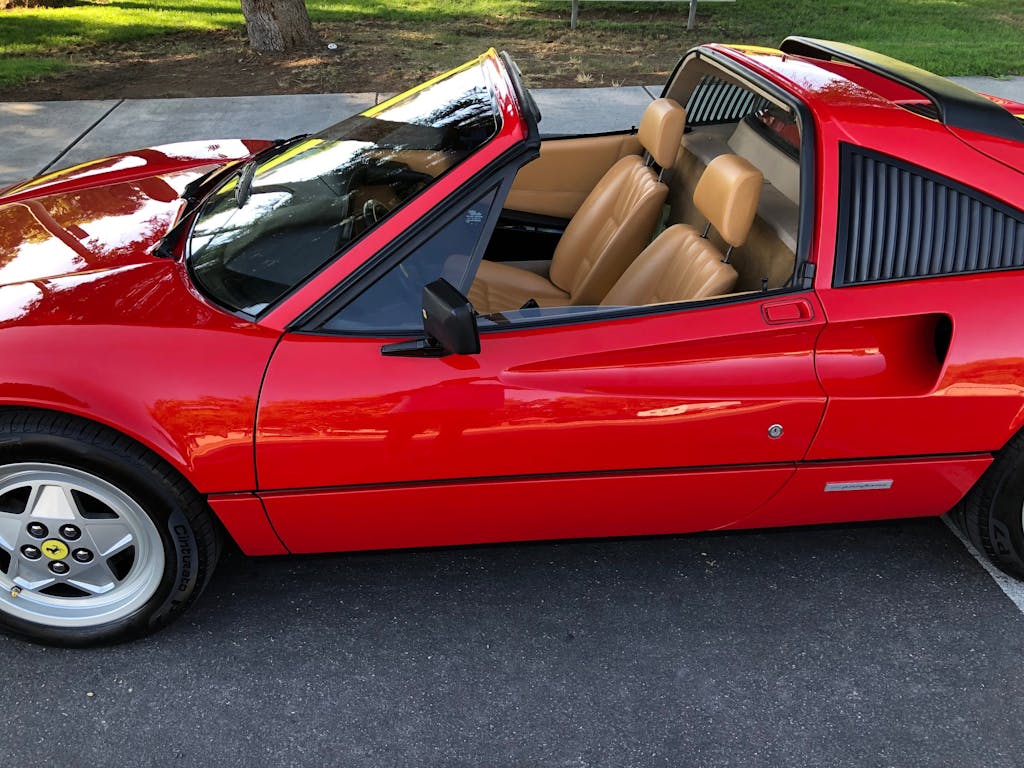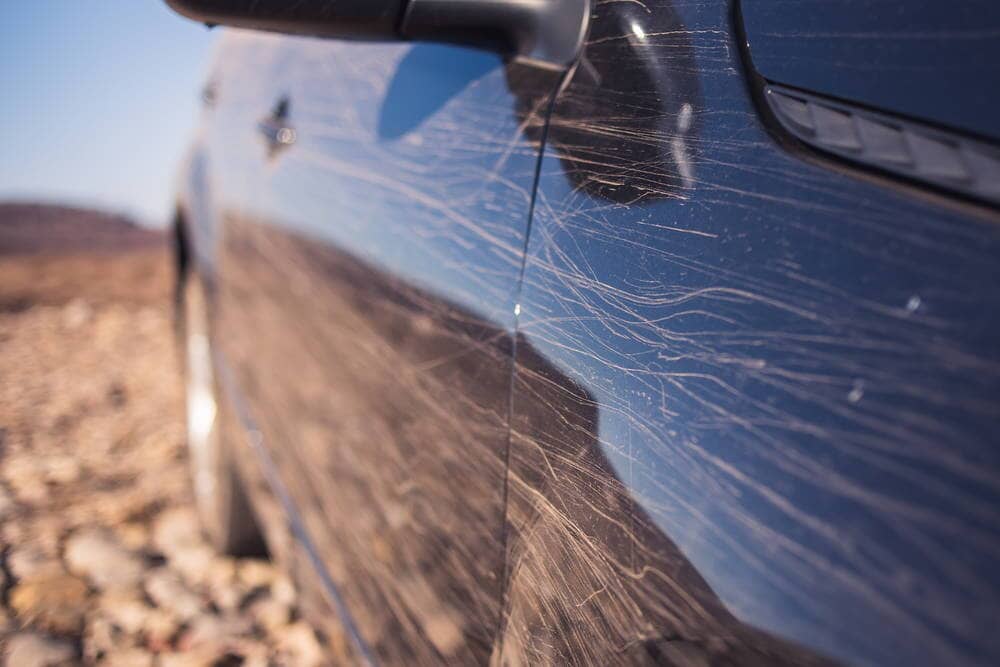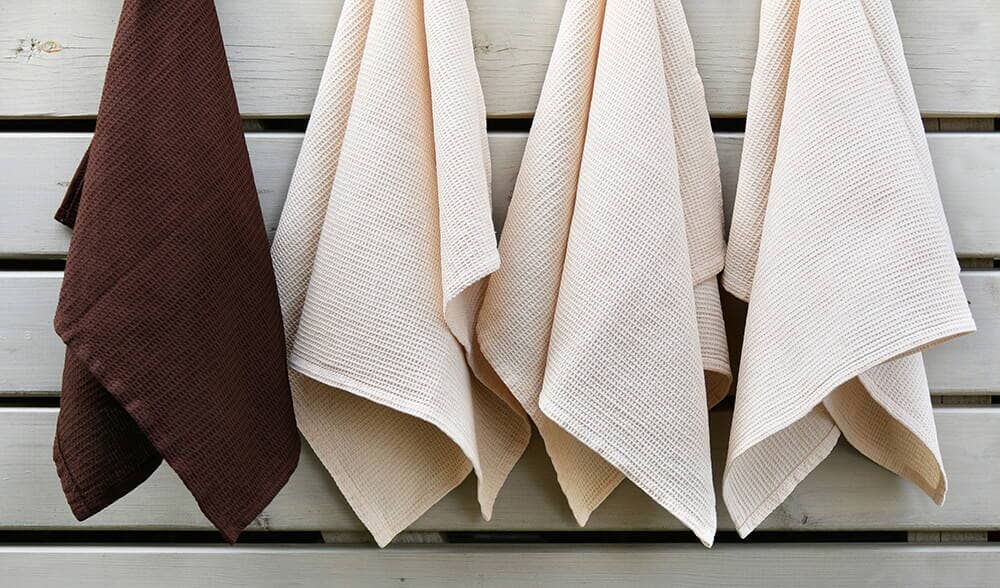Teenagers have a lot of stereotypes about what’s cool or not: comic books, video games, and anime have gone from being nerdish to being “lit”, wearing wireless AirPods while walking is “sick”, and a denim jacket tells everyone you’re a total “Chad”.
Thankfully, we’re a lot more sophisticated as adults. We would never say, for instance, that black is the manliest, sexiest hue that you can have on your car, and all the other colors are for girly girls.
That would be silly.
Right?
Reverse is the newest car detailing product that easily removes scratches and swirls by hand. This car scratch remover and car paint scratch repair compound will bring your paint back to new. It's also a water spot remover and swirl remover. Make paint correction easy with this all in one formula.
- Repair car scratches, swirl marks and water spots.
- Will also remove oxidation, spider marks and paint imperfections.
- Works by hand, no fancy tools needed.
Why Do Black Cars Show Scratches So Easily?
Contrary to popular belief, black paint doesn’t get damaged any more easily compared to other colors—they’re all made from the same formula. Every time your vehicle gets scuffed, however, it leaves a white mark behind. This doesn’t show as much when your car has a lighter paint job because the scratch simply blends in, but the problem with darker coats, especially black, is that the high contrast makes any marks more visible.
The First Step Of Any Paint Scratch Repair: Decontamination
Before attempting to repair scratches on your black car, you first need to get rid of any particles on the surface that might hinder the process. This includes dried-out wax, old ceramic coating layers, iron deposits, brake dust, dirt, bug splatters, bird droppings, water spots, and tree spots. Even if the car’s exterior looks clean, take note that many contaminants are invisible to the naked eye.
For this job, good ol’ soap and water will do just fine, but not regular soap. In fact, using something like dish soap to clean your automobile would be a disaster, because these detergents tend to strip away oils or any protective layer that comes with your car’s coating. You’ll need something that’s specially formulated to clean your vehicle’s paint without damaging its chemical structure.
This is where Torque Detail’s Decon Wash Pack comes in handy. The kit contains a mitt that you can use to wipe your car with, as well as an 8-ounce bottle of our specially formulated Decontamination Soap. Hose your car down first, then grab a bucket and mix the soap in with water (4 ounces for every 5 gallons). Use the wash mitt to scrub the grime off the surface with back-and-forth motions. Finally, hose the car down again to get rid of the suds.
Decon Soap will return your car to its pristine state, getting rid of any filth as well as layers of old wax or Ceramic Spray that you may have applied in the past.
Once your car has been decontaminated, you can now deal with the scratches.
Types Of Black Car Scratches
Not all scratches are created equal. In fact, some are far easier to get rid of than others.
Outlined below is a brief rundown of what you can expect when it comes to the different kinds of scratches, but before that, you might want to check on your own car using the fingernail test.
Recommended: The Types of Car Scratches
Recommended: The Ultimate Guide To Removing Scratches On ALL Cars
Detailer Pro Tip: The Fingernail Test
Your car’s exterior typically has four layers. First is the bare metal itself, which is either made up of carbon steel or aluminum. Unless someone took a sledgehammer to it, this layer will typically remain unscathed by normal wear-and-tear. Next is a bonding agent called a primer that sits on top of the metal and functions as a sort of glue that keeps the alloy and the paint stuck together. Above the primer is the base coat, which is the actual paint itself that gives your car its unique color. Finally, higher than the base coat is the clear coat, which acts as a water-resistant shield and is responsible for giving your car that glossy look.
Every time your car is scratched, it means that one or more of these layers have been damaged. If only the clear coat is affected, you can fix this yourself. However, if the scratch goes deeper into the base coat and beyond, you’ll have a bigger mess on your hands and might need the help of a professional detailer.
In order to tell how deep the scratch is, use the fingernail test. Simply drag your fingernail across the length of the scratch. If your nail “catches”, this means the scratch has gone past the clear coat. If your fingernail encounters no resistance, it means the scratch is only surface-deep and can be easily fixed.
Clear Coat Scratches
These are scratches that have not damaged the base coat paint itself. These scratches are very minor and can be made invisible with the right polish or product.
Deep Scratches (Paint Layer & Primer)
Once the scratch goes through the base coat and the primer, the paint itself has been damaged, and no amount of polishing will make the abrasion disappear. You will have to sand the area down, then apply a fresh layer of primer and/or coating using the same color as the manufacturer. Oftentimes, this work needs to be done by a professional.
Paint Transfer Scratch
This is a unique type of scratch that occurs when your car hits a painted object. With enough force, the paint from the object will transfer and stick onto your car. The good news is that the transferred paint normally just stays on the clear coat and will come off by scrubbing it with a sponge. However, if it goes deeper than that, you’ll be forced to apply a fresh layer of base coat.
How To Remove Black Car Scratches (Best Methods)
How To Fix Clear Coat Scratches
As mentioned above, these are the scratches that affect only the topmost layer of the car. They’re also referred to as surface scratches and are the easiest to repair.
What you’ll need:
Step 1.) Apply a small amount of Torque Detail Reverse onto the microfiber towel
Torque Detail Reverse is our own paint polisher that not only removes scratches, but also swirls, water spots, oxidation, spider marks, and other imperfections. It functions as an all-in-one repair compound that you can use for any minor damage to your car’s exterior.
Assuming you’ve already washed off any surface dust and dirt, simply apply a small amount of Torque Detail Reverse onto your microfiber towel.
Step 2.) Rub the formula into the scratch
Using the microfiber towel, rub the Torque Detail Reverse formula into the damaged surface with even strokes, following the grain of the scratch.
Step 3.) Wipe off any excess
If there is any excess formula left on the car, wipe it off with the clean side of your microfiber towel.
The scratch should now be completely gone, making your car look good as new.
How To Fix Deep Scratches (Paint Layer & Primer Scratches)
When the scratch has penetrated through the base coat and the primer, you’ll need to repaint the damage. Let’s fix those deeper scratches!
What you’ll need:
- High-grade sandpaper (2,000 or 1,500-grit)
- Automotive primer
- Base coat touch-up paint
- 1 microfiber towel
- (optional) 1 sanding pad
- (optional) 2 applicator sticks/matchsticks/toothpicks
Note: For a beginner, it’s safest to purchase your base coat and clear coat from the same place. Somewhere like TouchUpDirect.com is a good choice that provides complete touch-up kits.
Step 1.) Sand down the clear coat
Since the scratch has penetrated the base coat and/or primer, you will need to reach these layers, but the clear coat is blocking the way. Wrap the sandpaper around the sanding pad if you have one and begin buffing away the clear coat. Rinse with water occasionally so that you’ll know how far you’ve gone. Do this until the primer layer is exposed.
Step 2.) Apply car primer
Using an applicator stick or whatever you have on hand, apply a thin dab of car primer to the affected area. Make sure that it dries completely before moving on to the next step.
Step 3.) Apply car paint
Once the primer has dried, mix the car paint and apply it to the affected area. Make sure not to overdo it—only a thin layer is necessary. Furthermore, it’s absolutely essential that the color of the new paint matches that of the original. There should be a small plate underneath your driver’s side door with information on the specific paint number of your car—use this number when buying at the store. When in doubt, contact the manufacturer for more information.
After applying the paint, let it dry. This may take a few days, but once it’s settled in, the scratch should be gone.
If all of this sounds too much for you, you may want to hire a professional to handle things. The only downside to this is the cost, which may set you back by about $1,000 depending on the extent of the damage.
How To Fix Paint Transfer Scratches
Finally, there are paint transfer scratches or scuffs, which require a little muscle to eliminate.
What you’ll need:
- 1 lubricant (WD-40)
- 1 foam sponge
- 1 bucket of warm water
Step 1.) Apply the lubricant to the transferred paint
The WD-40 lubricant will soften the paint so that it will come off easily when you buff it later on with the sponge. Make sure to only apply this formula to the affected area since you don’t want to injure the car’s natural paint. Wipe off any excess WD-40 that wanders away from the damaged surface.
Step 2.) Rub off the transferred paint with the foam sponge
Dip the foam sponge into warm water and use it to rub the transferred paint until it comes off. You might need to apply more lubricant if you’re having a difficult time. Scrub in the same direction as the grain of the offending paint.
Lock In Your Work And Bring Back Shine With A Ceramic Coating
Once you’ve dealt with the scratches—whether minor, major, or paint transfers—it’s time to give your car a fresh ceramic coating. Chances are that the topmost layer or clear coat was damaged during the process. The clear coat serves as a protective shield and gives off that glossy shine, so if you don’t replenish it, your repaired paint will look dull and flat.
Thankfully, giving your car a fresh coat isn’t as hard as you might think. Torque Detail’s Ceramic Spray was built specifically for this purpose. It contains glass-like particles of silicon dioxide suspended in resin, which act as a sealant to fill in any microscopic gaps and holes in your car’s paint layer. What’s more, this product is designed to draw out and strengthen your car’s clear coat, making it impervious to water and elemental damage for up to 12 months.
To use Torque Detail’s Ceramic Spray, simply spray a small amount of the formula onto the repaired scratch and buff it with a clean microfiber towel. That’s it. In fact, it’s so easy to apply that you can cover the entire car if you want within minutes, giving you a vehicle that’s not only free from scratches but also looks as sleek and polished as the day it came out of the showroom.
Frequently Asked Questions (FAQs)
Will wax hide scratches?
Yes, wax will typically hide scratches, assuming they haven’t penetrated the base coat. Take note that the key word here is “hide”—the wax itself doesn’t actually fix the scratch, but just covers it, making it invisible to the naked eye. However, if the paint itself has been damaged, wax will be powerless to do anything.
How do car scratch removers work?
Scratch removers work by breaking down the clear coat and then filling in the scratch that has damaged the paint, thereby repairing it.
Are there any easy ways to hide black car scratches?
When you’re pinching pennies, you might not have enough budget to purchase professional-grade products that can repair scratches. The next best thing would be to use household items that can cover up the damage. At the top of the list is nail polish. Because of the wide variety of colors available, it’s quite easy to find one that matches your car. Another option is to use black shoe polish, which is especially helpful when you own a black car since both hues are the same. Apply them sparingly on top of the scratch and watch it fade away.
Toothpaste Scratch Removal: Fact Or Fiction?
Surprisingly enough, toothpaste actually works well in repairing scratches. This is because it contains microscopic abrasive elements that essentially act as a sandpaper on your car, buffing away any imperfections. Please note that this only works on light abrasions that affect the clear coat—anything deeper than that will need a replacement paint job. For best results, use a whitening toothpaste, since these are a lot grittier than regular toothpaste. Apply it onto a microfiber towel and wipe away the damage.
Summary
We’ve now seen how scratches on vehicles can be treated with a wide variety of options, from everyday household brands to top-of-the-line car care specialties like Torque Detail. It’s always best to remember, however, that prevention is better than cure. Nothing can beat being a careful driver and a meticulous owner who makes sure that his baby is kept in good shape all year round.
After all, as the kids like to say, YOLO. You only live once—so why not make the most of it?
★★★★★ Kent F. (1989 Ferrari 328): "I wanted to get remove the small scratches and swirl marks on the original paint without having to repaint the car. I check with some companies that go over and restore the paint to the original color however they wanted one thousand dollars or more to do it. So I thought that I would try your product because of the success that other people using this product had.
I was very happy and impressed with the results and how it got rid of the swirl marks and scratches. It may the paint a darker color red and brought back more of the original color. I also used the clay bar solution first and then the correction compound. Then I used the Ceramic Spray to finish the car. It looks beautiful. Thank you for making such great products."








